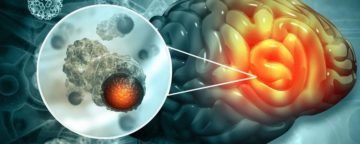Deanna MacNeil in The Scientist:
 Glioblastoma (GBM) is the most common and malignant form of primary brain cancer. More effective treatments for GBM are direly needed, as the median survival with current therapeutic options is 15 months. One difficulty that scientists face is developing GBM treatments that overcome therapeutic resistance. GBM tumor cells invade the surrounding brain tissue and acquire resistance mediated by factors in the tumor microenvironment (TME). Conventional drug screens that rely on tumor cells grown in culture lack the TME, highlighting the need for better screening models to overcome invasion-mediated therapeutic resistance.1
Glioblastoma (GBM) is the most common and malignant form of primary brain cancer. More effective treatments for GBM are direly needed, as the median survival with current therapeutic options is 15 months. One difficulty that scientists face is developing GBM treatments that overcome therapeutic resistance. GBM tumor cells invade the surrounding brain tissue and acquire resistance mediated by factors in the tumor microenvironment (TME). Conventional drug screens that rely on tumor cells grown in culture lack the TME, highlighting the need for better screening models to overcome invasion-mediated therapeutic resistance.1
Researchers use 3D models to study multiple types of cancer, but most current GBM models focus on examining one element of the TME at a time. Jennifer Munson, a bioengineer at Virginia Tech, created a model of the human GBM TME that incorporated patient-derived GBM stem cells, human astrocytes and microglia, and a biophysical force involved in tumorigenesis called interstitial fluid flow.2 The researchers evaluated their model based on four key metrics of GBM behavior—tumor cell death, invasion, proliferation, and stemness.
More here.
